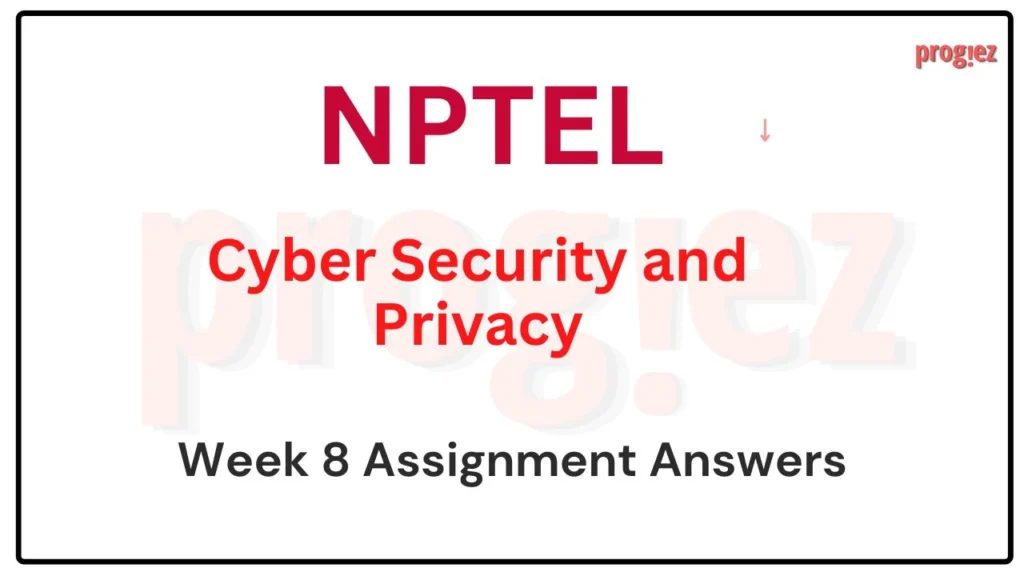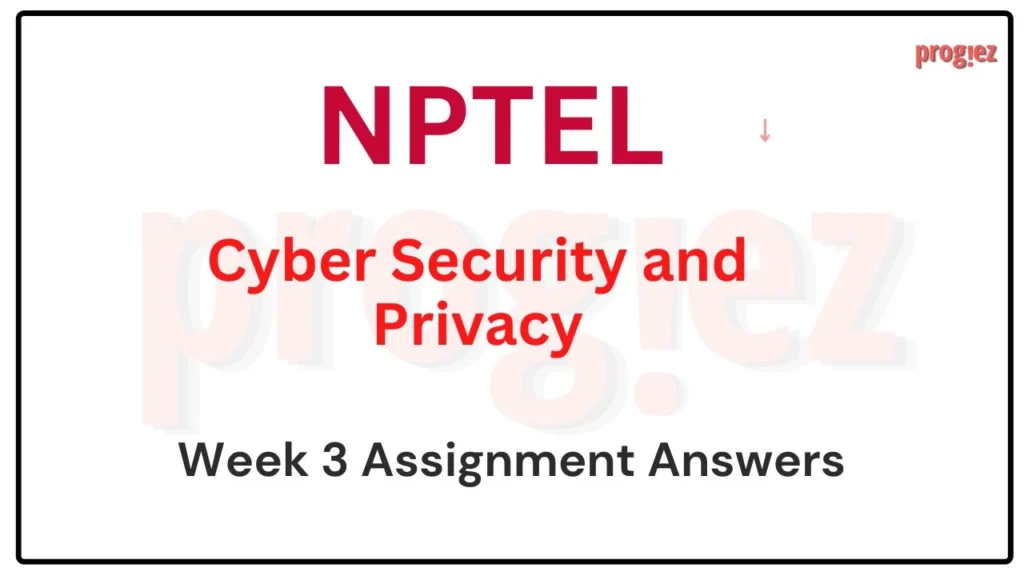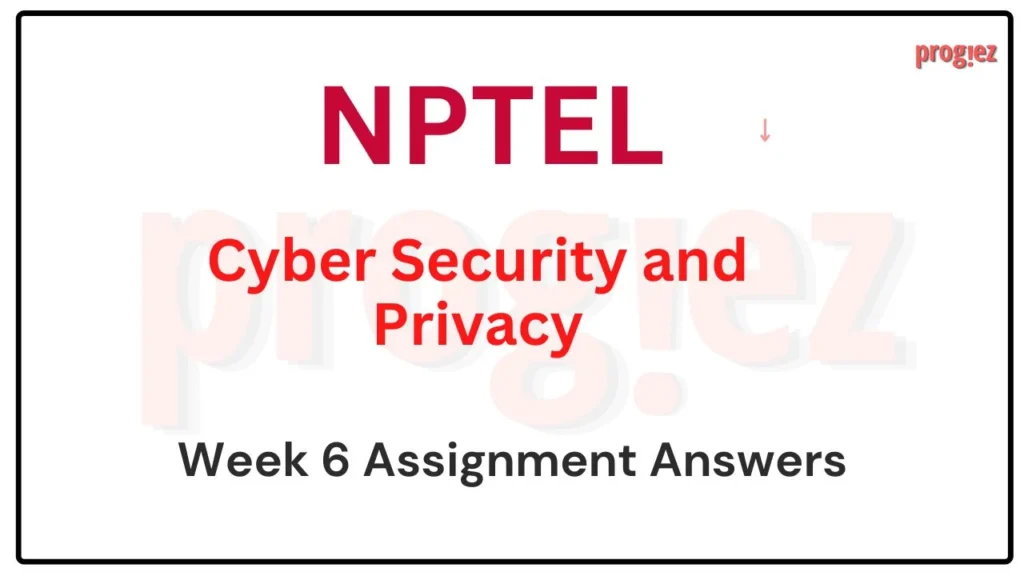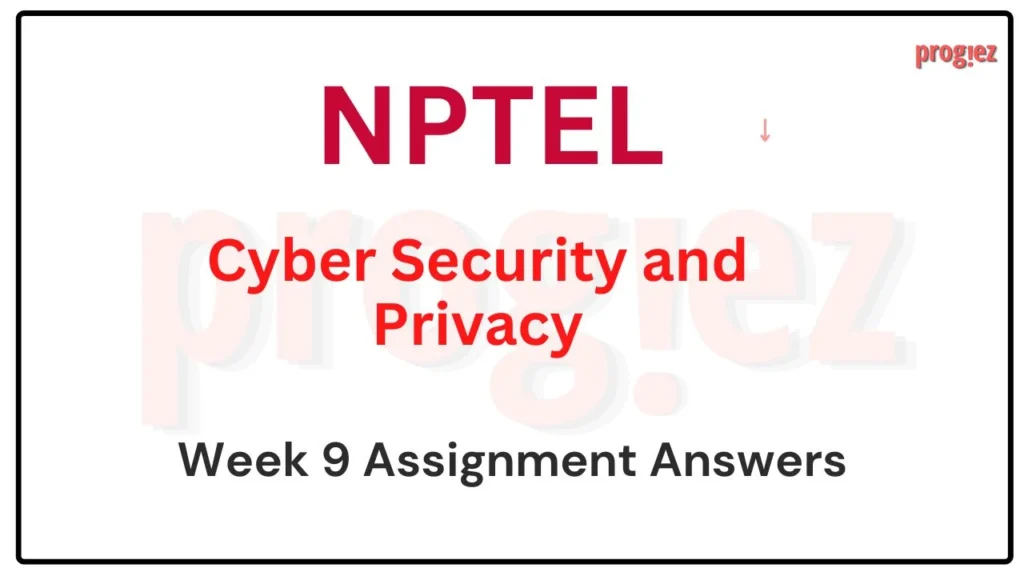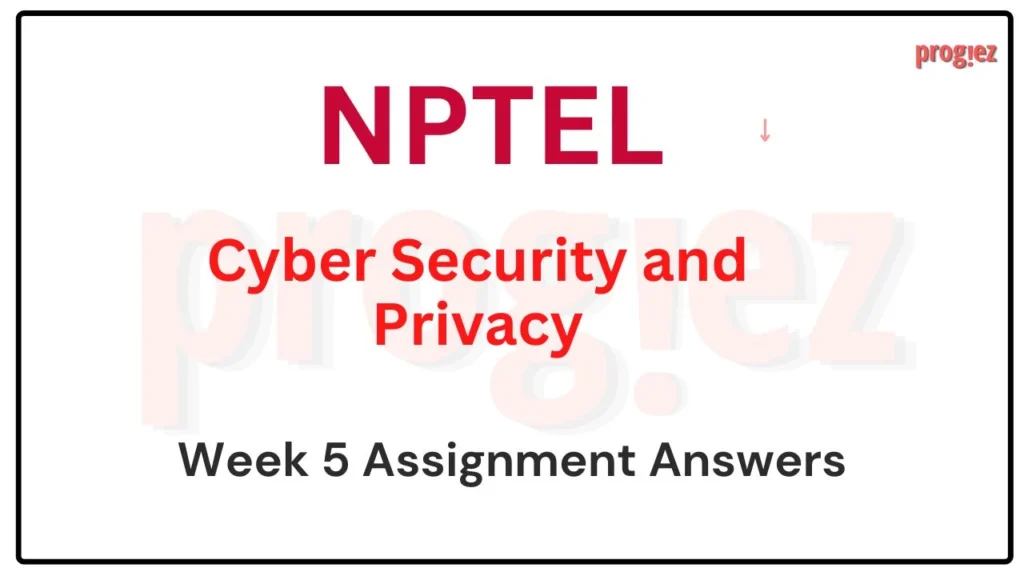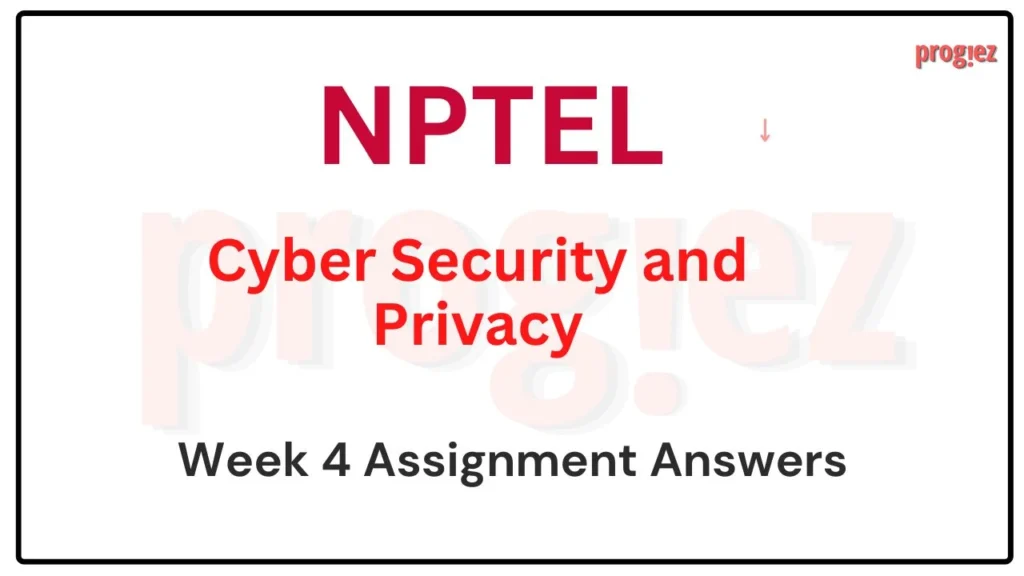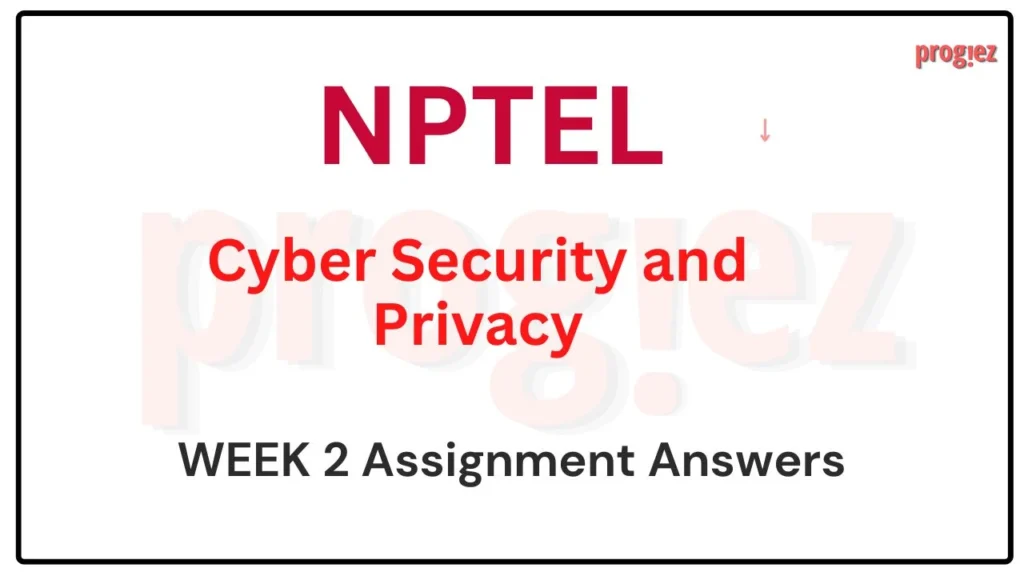Cyber Security and Privacy Week 7 Nptel Answers 2024
Are you looking for Cyber Security and Privacy Week 7 Nptel Answers? You’ve come to the right place! Access the latest and most accurate solutions for your Week 7 assignment in the Cyber Security and Privacy course.
Course Link: Click Here
Table of Contents
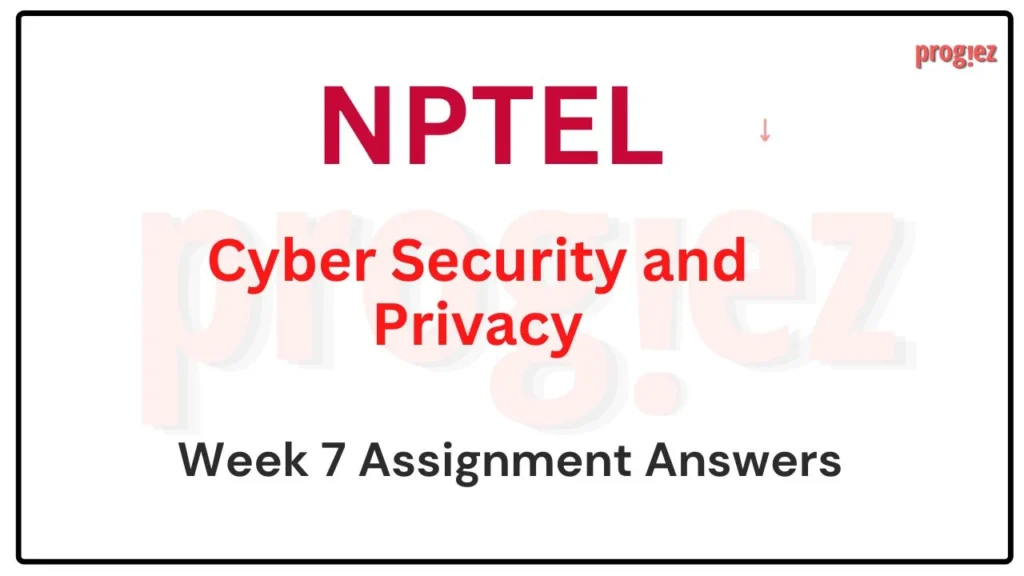
Cyber Security and Privacy Week 7 Nptel Answers (July-Dec 2024)
- __ is a comprehensive system comprising software, encryption techniques, protocols, legal arrangements, and third-party services that facilitate secure communication among users by utilizing digital certificates.
A) Registration authority
B) Public key infrastructure
C) Digital signature
D) Certificate authority
Answer: B) Public key infrastructure
- Which ring does the kernel, the core of the operating system, typically operate?
A) Ring 2
B) Ring 1
C) Ring 0
D) Ring 3
Answer: C) Ring 0
- Which of the following statements is not true?
A) Hash functions are one-way.
B) It is possible to attach a message authentication code (MAC) to allow only specific recipients to access the message digest.
C) Hashing functions require the use of keys.
D) Hash functions are used in password verification systems to confirm the identity of the user.
Answer: C) Hashing functions require the use of keys.
- Which of the following is not related to defense against rainbow cracking?
A) Password hash salting
B) Key stretching
C) Key strengthening
D) Private key encryption
Answer: D) Private key encryption
- Which of the following statements is/are correct?
A) TCP is a connection-oriented protocol, while UDP is connectionless.
B) TCP is comparatively faster than UDP.
C) TCP provides reliable data delivery, while UDP does not.
D) Both a and c.
Answer: D) Both a and c.
- Which of the following statements about Virtual Private Networks (VPN) are true?
A) A VPN is an encrypted connection over the Internet from a device to a network.
B) A VPN keeps the contents of the network messages hidden from observers who may have access to public traffic.
C) A VPN protects its users by masking their IP address.
D) All the above.
Answer: D) All the above.rogress
- Endpoint Detection and Response (EDR) solutions are primarily focused on:
A) Securing network perimeters and firewalls.
B) Protecting individual user devices from threats.
C) Monitoring and analyzing network traffic for malicious activity.
D) Providing vulnerability assessments for servers and applications.
Answer: B) Protecting individual user devices from threats.
- Cryptojacking is a cyber attack that leverages a victim’s computer resources for the attacker’s financial gain. Which of the following best describes the attacker’s activity in a cryptojacking attack?
A) Encrypting the victim’s data and demanding a ransom payment.
B) Gaining unauthorized access to the victim’s personal information for resale.
C) Silently using the victim’s processing power to solve complex mathematical problems for financial reward.
D) Disrupting the normal operation of the victim’s system to cause inconvenience.
Answer: C) Silently using the victim’s processing power to solve complex mathematical problems for financial reward.
- What kind of infrastructure Advanced Persistent Threat (APT) groups are typically known for targeting?
A) Personal computers of home users.
B) Critical infrastructure essential for national security (e.g., power grids, communication networks).
C) Public Wi-Fi networks at cafes or airports.
D) Outdated operating systems on personal devices of insignificant value
Answer: B) Critical infrastructure essential for national security (e.g., power grids, communication networks).
- Which of the following is NOT one of the stages in the Intrusion Kill Chain framework?
A) Reconnaissance
B) Exploitation
C) Cleanup
D) Command and Control
Answer: C) Cleanup
These are Cyber Security and Privacy Week 7 Nptel Answers
All Weeks of Cyber Security and Privacy: Click here
For answers to additional Nptel courses, please refer to this link: NPTEL Assignment
Cyber Security and Privacy Week 7 Nptel Answers (July-Dec 2023)
Course Name: Cyber Security and Privacy
Course Link: Click Here
These are Cyber Security and Privacy Nptel Assignment 7 Answers
Q1. Which VPN technology uses leased circuits from a service provider and conducts packet switching over these leased circuits?
Secure VPN
Hybrid VPN
Trusted VPN
Transport VPN
Answer: Trusted VPN
Q2. The biometric technology criteria that describe the number of legitimate users who are denied access because of a failure in the biometric device in known as
False reject rate
False accept rate
Crossover error rate
Accountability rate
Answer: False reject rate
Q3. True or False: All traffic exiting from the trusted network should be filtered.
True
False
Answer: False
Q4. What term is used to describe decoy systems designed to lure potential attackers away from critical systems?
Trap
Honeypot
Trace
Sniffer
Answer: Honeypot
Q5. True or False: Signature-based IDPS technology is widely used because many attacks have clear and distinct signatures.
True
False
Answer: True
Q6. The method by which systems determine whether and how to admit a user into a trusted area of the organization is known as
Attribute
Accountability
Access control
Audibility
Answer: Access control
These are Cyber Security and Privacy Nptel Assignment 7 Answers
Q7. ——————denotes the rate at which fraudulent users or nonusers are allowed access to systems or areas as a result of a failure in the biometric device. This failure is also known as ————–
False reject rate, Type I error
False accept rate, Type 2 error
False accept rate, Type I error
False reject rate, Type 2 error
Answer: False accept rate, Type 2 error
These are Cyber Security and Privacy Nptel Assignment 7 Answers
Q8. Fill in the blank
——————denotes the rate at which authorised users are denied access to systems or areas as a result of a failure in the biometric device. This failure is also known as ————.
Choose the correct option
False reject rate, Type I error
False accept rate, Type 2 error
False accept rate, Type I error
False reject rate, Type 2 error
Answer: False reject rate, Type I error
Q9. Match the following
A. Thresholds 1 Signature-based detection
B. Blacklists and whitelists: 2 Anomaly-based detection
C. Alert settings: 3 Detection-related related programs
D. Code viewing and editing: 4 Specifying which prevention capabilities
Choose the correct option
A-2, B-3, C-1, D-4
A-2, B-1, C-3, D-4
A-1, B-2, C-3, D-4
A-2, B-1, C-4, D-3
Answer: A-2, B-1, C-4, D-3
These are Cyber Security and Privacy Nptel Assignment 7 Answers
Q10. Choose the right option to fill in the blanks
(1) ————— initiates network traffic to find and evaluate service ports whereas (2) —————- uses traffic from the target network segment to evaluate the service ports available from hosts on that segment.
1-active vulnerability scanners, 2-passive vulnerability scanners
1-passive vulnerability scanners, 2-active vulnerability scanners
Answer: 1-active vulnerability scanners, 2-passive vulnerability scanners

